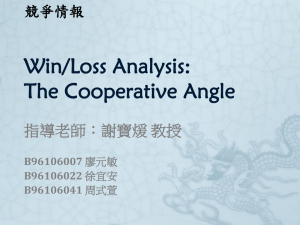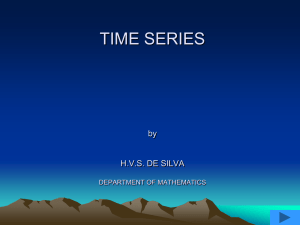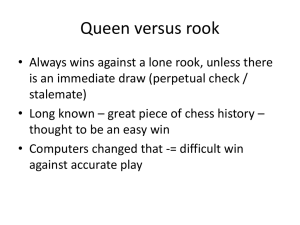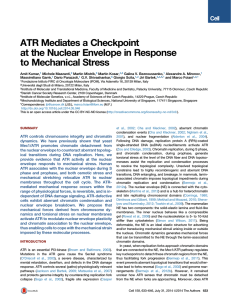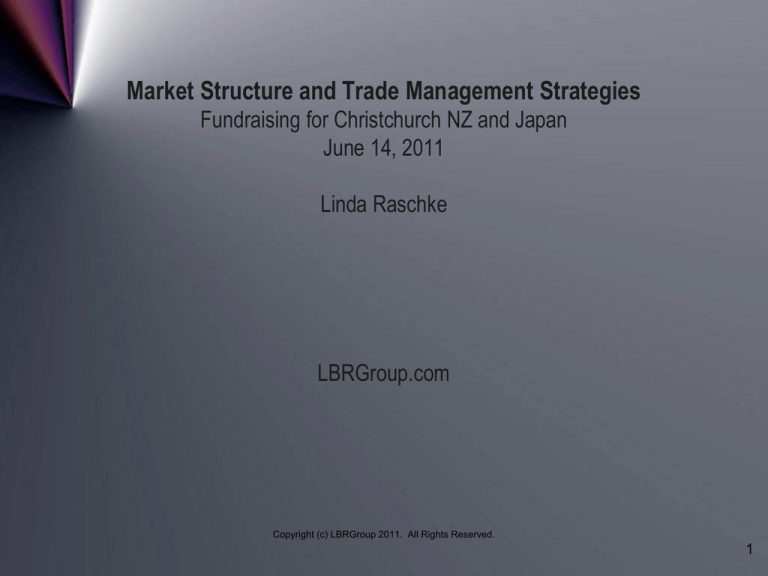
Market Structure and Trade Management Strategies
Fundraising for Christchurch NZ and Japan
June 14, 2011
Linda Raschke
LBRGroup.com
Copyright (c) LBRGroup 2011. All Rights Reserved.
1
There is a free 133 page manual you can download
that elaborates much more on structure, swing
trading, execution and market psychology at:
FuturePathTrading.com
This power point presentation will be posted to
lbrgroup.com for you to download on Wednesday.
Copyright (c) LBRGroup 2011. All Rights Reserved.
2
Filtered Waves – Basic Theory
Arthur Merrill, 1977
• Arthur Merrill’s filtered waves used a percentage of price movement
(5%) to filter out the noise. His work was important because he
dedicated a whole book to the concept of classifying patterns by the
wave structure.
• Gann was probably the most popular predecessor of swing charting.
• Welles Wilder documented the use of ATR (Average True Range)
functions to quantify swings as opposed to percent functions. This
was applied to a system called the Volatility stop and reverse
system.
• Merrill’s work was far more comprehensive, in that not only did he
classify previous market structures, he also developed classic
actuarial tables, or probability grids, to measure the median %
increase/decrease and duration of bull and bear markets.
Copyright (c) LBRGroup 1996-2006. All Rights Reserved.
3
Market Structure as measured by Swings
Waves eliminate “noise” and thus make is easier to determine TREND
Additionally, the absolute support and resistance are one more way
of adding structure. While Art Merrill used a percent function, we use
an ATR function. A new Up Wave starts when price moves 3 ATRs
up from the lowest low or lowest close over 15-period look-back. A
new Down wave starts when price moves 3 ATR’s down from the
highest high or highest close over 15-period look back period.
Once market swings have been quantified, relationships, turning points,
and trend can once again be classified, counted, examined and
expressed in numbers. We can start to build a probability grid,
evaluating trade management strategies.
Copyright (c) LBRGroup 1996-2006. All Rights Reserved.
4
Market Waves Define Structure
Copyright (c) LBRGroup 1996-2011. All Rights Reserved.
5
SP index – waves define structure and trade opportunity. Some wave patterns lead to small wins, some have
above average odds of a bigger win.
Copyright (c) LBRGroup 1996-2006. All Rights Reserved.
6
Wave Structure
Copyright (c) LBRGroup 1996-2006. All Rights Reserved.
7
BNI – Wave structure is one of the primary basis of a trade.
Copyright (c) LBRGroup 1996-2006. All Rights Reserved.
8
Gold – Wave structure is one of the primary basis of a trade.
Copyright (c) LBRGroup 1996-2006. All Rights Reserved.
9
Trend Reversal in Sugar
Copyright (c) LBRGroup 1996-2011. All Rights Reserved.
10
Rising Wedge w converging Trendlines – Crude – play for big win or trail stop.
Copyright (c) LBRGroup 1996-2011. All Rights Reserved.
11
IBM – Weekly chart shown “clean structure” The higher
time frames have less noise.
Copyright (c) LBRGroup 1996-2011. All Rights Reserved.
12
IBM – Daily Chart
Copyright (c) LBRGroup 1996-2011. All Rights Reserved.
13
Trend Reversal from up to down again – Weekly chart
Copyright (c) LBRGroup 1996-2006. All Rights Reserved.
14
Indicators based off a derivative of price can be misleading. Structure must
always come FIRST. Then the indicators can be put in a context.
Copyright (c) LBRGroup 1996-2006. All Rights Reserved.
15
Wave Structure – Dollar in an up trend
Copyright (c) LBRGroup 1996-2006. All Rights Reserved.
16
Waves structure still shows uptrend
Copyright (c) LBRGroup 1996-2006. All Rights Reserved.
17
Uptrend still intact, volatility contracting
Copyright (c) LBRGroup 1996-2006. All Rights Reserved.
18
Trend Reversal Down when “Power Buy” fails
Copyright (c) LBRGroup 1996-2006. All Rights Reserved.
19
Up waves are now shorting opportunities
Copyright (c) LBRGroup 1996-2006. All Rights Reserved.
20
The first trend reversal up
Copyright (c) LBRGroup 1996-2006. All Rights Reserved.
21
The trend in 30-year yields reversed on the daily charts at the end of 2005.
Copyright (c) LBRGroup 1996-2006. All Rights Reserved.
22
A failed bear flag is the same as a failure test or failure swing. The breakout
from this equilibrium point did not lead to a big win. A trailing stop may have
still led to a small win.
Copyright (c) LBRGroup 1996-2006. All Rights Reserved.
23
Yield chart – extreme example of reaction up in downtrend. Despite the sharp
swing up, the wave structure for rates remained in a steady downtrend in
2004.
Copyright (c) LBRGroup 1996-2006. All Rights Reserved.
24
How can structure aid in identifying the sweet
spots in the data?
Trailing stops more often then not degraded most
systems built from relatively simple rules. There are no
combination targets and stops, even with the use of one
filter, where it is more profitable to trail a stop then
playing for a small win. However, using two time frames,
can help identify “sweet spots’” in the data that do lead to
bigger wins or a higher then average expectation of
greater trendiness.
Copyright (c) LBRGroup 1996-2011. All Rights Reserved.
25
Trailing Stop Functions
• ONLY should be used at specific
structural points!
• Breakouts, Trend reversals as defined by
the wave structure, and after
A-B-C formations in a trending market
Copyright (c) LBRGroup 1996-2006. All Rights Reserved.
26
“Sweet spot” with detail on short time frame
Copyright (c) LBRGroup 1996-2006. All Rights Reserved.
27
Trend reversal on hourlies precedes trend reversal on higher time frame.
Copyright (c) LBRGroup 1996-2006. All Rights Reserved.
28
Comparison of different structural points – small target versus large target
Copyright (c) LBRGroup 1996-2006. All Rights Reserved.
29
Japan Index – Trend reversal is a Process!
Copyright (c) LBRGroup 1996-2006. All Rights Reserved.
30
Russell 2000 – Weekly Chart
Copyright (c) LBRGroup 1996-2006. All Rights Reserved.
31
Russell 2000 – Daily chart
Copyright (c) LBRGroup 1996-2006. All Rights Reserved.
32
SP 500 – Weekly Chart
Copyright (c) LBRGroup 1996-2006. All Rights Reserved.
33
DJ Utilities Index – Weekly Chart
Copyright (c) LBRGroup 1996-2006. All Rights Reserved.
34
Brazil – Daily Chart
Copyright (c) LBRGroup 1996-2006. All Rights Reserved.
35
Brazil – Daily Chart – after a momentum move, the market consolidates
with lots of “noise”.
Copyright (c) LBRGroup 1996-2006. All Rights Reserved.
36
REMEMBER – “textbook” trades occur a small percentage of the time
ONLY. This is a game based on probabilities where overtime you will have
a small edge and hopefully you will “get lucky” once in a while.
Copyright (c) LBRGroup 1996-2006. All Rights Reserved.
37
Weekly Dollar Index
Copyright (c) LBRGroup 1996-2006. All Rights Reserved.
38
Dollar Index – Daily Chart
Copyright (c) LBRGroup 1996-2006. All Rights Reserved.
39
Dollar Index – Hourly Chart
Copyright (c) LBRGroup 1996-2006. All Rights Reserved.
40
Goldman Sachs Spot Index - Weekly
Copyright (c) LBRGroup 1996-2006. All Rights Reserved.
41
GSI – Daily chart with more data
Copyright (c) LBRGroup 1996-2006. All Rights Reserved.
42
Copper Intraday – detail of failed A B C
Copyright (c) LBRGroup 1996-2006. All Rights Reserved.
43
Wheat - Daily
Copyright (c) LBRGroup 1996-2006. All Rights Reserved.
44
Wheat – hourly chart
Copyright (c) LBRGroup 1996-2006. All Rights Reserved.
45
4 Basic Patterns:
Simple continuation pattern (bull or bear flag in a trend):
Enter with limit order or market order, play for small win (.5 to
1.5 ATR), Initial Risk 2 ATR. Tighten stop when market
moves in your favor.
Corrective A-B-C: enter after you see your stop point,
Play for big win (more then 1 ATR) or new highs or lows.
Initial Risk: 1 ATR from swing high or low.
Failed A-B-C (trend reversal): Enter on buy or sell stop,
play for big win or trail stop. Initial Risk: 1 ATR
Breakout from converging trendlines. Enter with buy
or sell stop or market order, add on first consolidation or
pause. Trail stop or play for big win. Initial Risk: 1ATR from
first entry.
Copyright (c) LBRGroup 1996-2006. All Rights Reserved.
46
Simple bear flag after a break down from a sideways line and a lower high.
Copyright (c) LBRGroup 1996-2006. All Rights Reserved.
47
First Flag after breakout CAN play for Big Target.
Copyright (c) LBRGroup 1996-2006. All Rights Reserved.
48
Bear flags late in the swing: small target ONLY.
Copyright (c) LBRGroup 1996-2006. All Rights Reserved.
49
Corrective A-B C or “Power Sell” in a downtrending market. Note momentum
move after break from sideways line. Play for new lows.
Copyright (c) LBRGroup 1996-2006. All Rights Reserved.
50
Corrective A-B C or “Power Sell” in a downtrending market. Note momentum
move after break from sideways line. Play for new lows.
Copyright (c) LBRGroup 1996-2006. All Rights Reserved.
51
Corrective A B C or “Power Sell”. The first is at the end of a swing. The
second comes after a fresh break from a sideways line.
Copyright (c) LBRGroup 1996-2006. All Rights Reserved.
52
“Failed” A-B-C or trend reversal point. Trail a stop.
Copyright (c) LBRGroup 1996-2006. All Rights Reserved.
53
Breakout from converging trendlines (wedge): Trail Stop
Copyright (c) LBRGroup 1996-2006. All Rights Reserved.
54
Bunds….active rhythmic market with volume. Breakout from converging
trendlines and Power Buy (A-B-C)
Copyright (c) LBRGroup 1996-2006. All Rights Reserved.
55
Initial Risk at Keltner Channel, Trail stop once Parabolic Kicks in
Copyright (c) LBRGroup 1996-2011. All Rights Reserved.
56
DAILY CRUDE – VOLATILITY STOP
Copyright (c) LBRGroup 1996-2006. All Rights Reserved.
57
Volatility Stops
• ATR = Average True Range
• 3 ATR +/- highest high or lowest low of
last 10 bars
• 3 ATR +/- moving average of close, high
or low.
Copyright (c) LBRGroup 1996-2006. All Rights Reserved.
58
Testing for the Edge
• Randomly entering a position can produce a profit 65%
of the time. By applying simple filters, random entry can
become breakeven or even slightly profitable.
• This data gives a benchmark for a systematic trader to
beat in order ensure the system is successful due to
more then capitalizing off noise. “Noise” is analogous
with random price data.
• Let’s go through a 5 step exercise using a randomizer to
generate trade entries as a departure point for modeling
price behavior.
Copyright (c) LBRGroup 1996-2006. All Rights Reserved.
59
Relationship between targets & stops with random entries
• Stop and reverse off randomly generated trade points yields a 50%
win/loss ratio as well as a profitable system 50% of the time.
• Random entry with Large Target and Large Stop (3 ATRs): The
win/loss ratio still hovers around 50%. (3 ATRs is just outside the
“noise’ inherent in price action).
• Random entry with Small Target and Large Stop (1ATR/3ATR). The
win/loss ratio jumps up to 70%+. While the chances of getting 1
ATR before a 3 ATR stop is hit are greater then 70%, it still is not a
profitable system. If we use a target of .5 ATRs and leave the large
stop in place, the win % jumps to 82%. The increase in % win
should be encouraging for the short term discretionary trader.
• Random entry with Small Target and Time Stop (1ATR/8bars).
Though the % win drops to 65%, the size of the average loss
decreases. So, while a larger fixed stop gives a trade more time to
be profitable, a discretionary trader may choose to exit if the trade
does not work within a reasonable amount of time.
Copyright (c) LBRGroup 1996-2011. All Rights Reserved.
60
A profitable system that is durable and robust based off random entries!
• At this point we know we can randomly enter a trade and get better
then an 80% win rate on most markets. By adding a trend filter,
random entries can be made into a profitable system.
• Only long entries are taken in an up trend and only short entries are
taken in a downtrend. (Again, all entries are at randomly generated
points). The Profit Target is 4 ATRs and the Stop Level is set to 3
ATRs (just outside of the “noise”). This ensures that if we can get
better then a 50% win rate, the system will be profitable.
• This system was run 100 times on each market with randomly
generated trade entries each time. The time period tested was from
1995 to 2005 on 22 domestic futures markets that included
currencies, bonds, index futures, metals, agricultural products, and
softs.
Copyright (c) LBRGroup 1996-2011. All Rights Reserved.
61
Statistical profile of random system with one Trend Filter:
• The system was profitable between 92 – 100% of the
time on all markets with the exception of live cows and
hogs, (which tend not to trend for extended periods of
time), as well as silver and natural gas – (probably due
to its extreme spiky nature in recent years). All index
futures were profitable 100% of the time over 100
randomly generated runs over 10 years of daily data!
• This is not a recommendation to trade this way, but
RANDOMLY generated entries can lead to profitable
strategies with use of one filter if stops are placed just
beyond the noise and a larger target is played for.
Copyright (c) LBRGroup 1996-2006. All Rights Reserved.
62
Summary:
• Random entry produces a high win/loss rate when the stop is large
enough to be just outside the “noise”. By using a time stop, we can
avoid taking repeated large losses at the expense of a slightly lower
win rate. With addition of one trend filter, a larger target can be
played for.
• These raw statistics provide a hurdle that a system must exceed in
order to produce better then random results. A system can be
considered better then random entry when:
• The drawdowns are smaller, or
• The P&L is substantially larger then random entry, or
• The win rate is significantly higher then that of random entry.
• The first step to improving a system is by the addition of some type
of trend filter. The greatest edge us trading in the direction of the
trend.
Copyright (c) LBRGroup 1996-2006. All Rights Reserved.
63
Relationship between Entries, Stops, and Profits
• There is not always a relationship between a trade is
entered and where a trade is stopped out.
– For example, with time based stops, the stop out level
has no relationship to the initial entry price.
• It’s not necessarily the entry that makes a model or
system successful. It’s all about the exit strategy!
• The larger the target, the lower the % win rate.
• The smaller the target, the fewer times the stop will be hit (all
else being equal).
• The wider the stop, the higher the % win rate.
Copyright (c) LBRGroup 1996-2006. All Rights Reserved.
64
Momentum Driven Models
•
While Volatility and Channel breakout systems are purely price driven,
momentum functions are based on a derivative of price. Momentum has
many interesting properties, including a leading function for price. The
tradeoff is an increase in “noise” over smoothed functions such as moving
averages, which have a lag. What is the best combination of exit strategies,
stops and targets to compensate for this increase in noise?
•
A variety of look back periods for momentum functions were examined and
tested against permutations of fixed targets ranging from .5 ATRs to 3
ATRs. Fixed stops, time stops, as well as delayed entries (so as not to be
entering on a “momentum spike” were also tested.
•
Similar conclusions could be drawn as what was modeled with random
entry systems:
•
Smaller targets are more profitable then Large targets, Time stops are
better then fixed stops, and Time stops combined with Fixed stops are
optimal. Momentum driven models perform better with a weighting given to
additional use of time stops which was not the case with random generated
entries.
Copyright (c) LBRGroup 1996-2006. All Rights Reserved.
65
The End!
Thanks for Attending.
ATR (Average True Range) Stops
(a most important concept!)
• ATR = Average True Range
• “True Range” includes “gap” area + Day’s
range
• ATR is a moving average of the past Ndays “True Range”.
Copyright (c) LBRGroup 1996-2011. All Rights Reserved.
67





